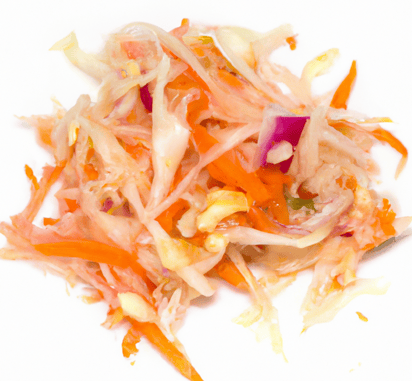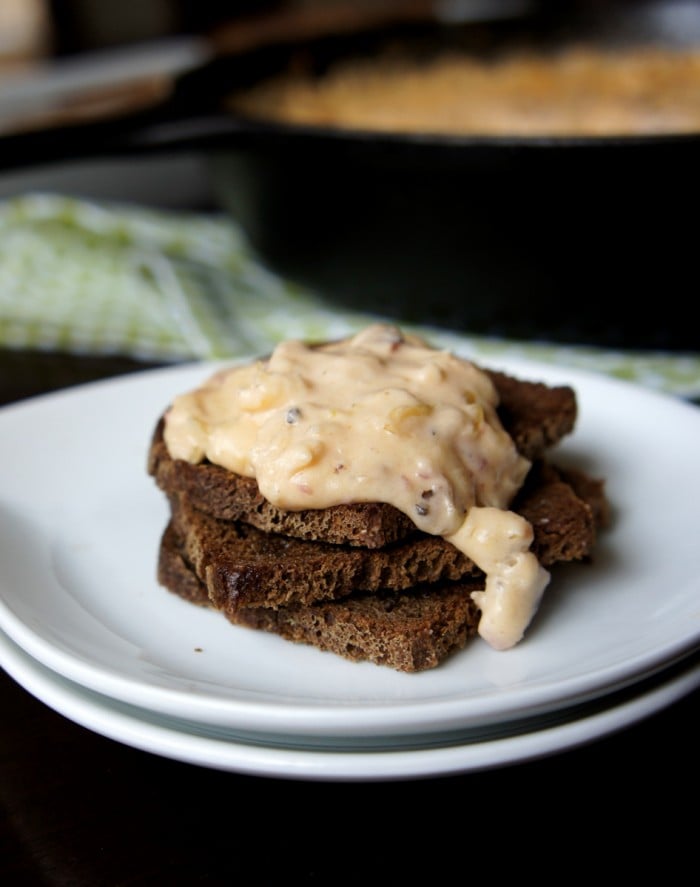Sauerkraut: Important Facts, Health Benefits, and Recipes
Explore the health benefits, history, and culinary uses of sauerkraut, a nutritious fermented cabbage dish, and learn how to store, substitute, and incorporate it into various recipes.

Nutritional Facts
1 cup
Amount per serving
Calories
27
Carbohydrates
6.1 g
Fat
0.2 g
Protein
1.3 g
Saturated Fat
0 g
Sodium
938.6 mg
Fiber
4.1 g
Sugar
2.5 g
Best Sauerkraut Recipes
-

-

-

-

-

-

-

-

-
![Summer Brats and Sauerkraut Tray Image]()
-
![Pastrami Reuben Egg Rolls Image]()
-
![Instant Pot Smoked Sausage Stew Image]()
-
![Ale-Braised Bratwurst and Sauerkraut Image]()
-
![Classic Reuben Sandwich Image]()
-
![Reuben Pull Apart Bread Image]()
-
![Healthy Potato Salad Image]()
-
![Pork Chop and Sauerkraut Bake Recipe Image]()
-
![Slow Cooker Kielbasa Recipe With Sauerkraut and Apple Image]()
-
![Romanian Stuffed Cabbage (Sarmale) Recipe Image]()
-
![Serbian Stuffed Cabbage (Sarma) Recipe Image]()
-
![Polish Pork Ribs & Sauerkraut (Zeberka Wieprzowe) Recipe Image]()
-
![German Sausage and Sauerkraut Recipe Image]()
-
![Easy Sausage Bake With Sauerkraut and Apples Recipe Image]()
-
![Make Traditional Polish Sauerkraut Pierogi Image]()
-
![Bigos (Polish Hunter’s Stew) Image]()
-
![Spare Ribs, Cabbage, and Sauerkraut Recipe Image]()
-
![Veal Goulash with Sauerkraut Recipe Image]()
-
![Stuffed Pork Chops with Kielbasa and Sauerkraut Recipe Image]()
-
![Reuben Casserole Recipe Image]()
-
![Stuffed Cabbage Rolls Recipe Image]()
-
![Sauerkraut with Bacon and Apples Recipe Image]()
-
![Franks and Sauerkraut Paprikash Recipe Image]()
-
![Bavarian Sauerkraut Recipe Image]()
-
![Reuben Sandwich {Delicious Classic} Image]()
-
![Toltott Kaposzta: Hungarian Stuffed Cabbage Recipe Image]()
-
![Polish Sauerkraut Soup (Kapusniak) Recipe Image]()
-
![Polish Sauerkraut and Mushroom Pierogi Recipe Image]()
-
![Ukrainian Sauerkraut Soup (Kapusnyak) Recipe Image]()
-
![Spareribs and Sauerkraut Recipe Image]()
-
![Corned Beef and Sauerkraut Casserole Image]()
-
![Croatian Stuffed Cabbage Recipe Image]()
-
![Reuben or Rachel Sandwich Recipe Image]()
-
![Slovak Holubky Stuffed Cabbage Recipe Image]()
-
![Slovak Bobalki With Sauerkraut Recipe Image]()
-
![Crock Pot Hungarian Stuffed Cabbage Rolls Recipe Image]()
-
![Sauerkraut and Apples Side Dish Recipe Image]()
-
![Polish Smoked Sausage and Sauerkraut Recipe Image]()
-
![Polish Cabbage and Sauerkraut (Kapuśniak) Soup Recipe Image]()
-
![Slow Cooker Pork, Sauerkraut, and Sausage Recipe Image]()









:max_bytes(150000):strip_icc()/pork-chop-sauerkraut-bake-15-56a8bad83df78cf772a02556.jpg)
:max_bytes(150000):strip_icc()/sauerkrautsausage-563386505-56c783393df78cfb3788bd12.jpg)
:max_bytes(150000):strip_icc()/romanian-stuffed-cabbage-recipe-sarmale-1137278-hero-01-710833f8c8c74c589992f27a4041f73a.jpg)
:max_bytes(150000):strip_icc()/serbian-stuffed-cabbage-recipe-sarma-1136569-hero-01-e874d6a9f7d74101a4a80f7465cbcfc7.jpg)
:max_bytes(150000):strip_icc()/polish-country-style-ribs-and-sauerkraut-1137036-hero-1-e814f08f5aff48159490eb93ab170d14.jpg)
:max_bytes(150000):strip_icc()/german-sausage-and-sauerkraut-482586-hero-01-5c3aa40b46e0fb00018b12fb.jpg)
:max_bytes(150000):strip_icc()/sauerkraut-kielbasa-18-56a8c0bf3df78cf772a0510d.jpg)
:max_bytes(150000):strip_icc()/sauerkraut-pierogi-1-56a279243df78cf7727670fe.jpg)
:max_bytes(150000):strip_icc()/__opt__aboutcom__coeus__resources__content_migration__simply_recipes__uploads__2010__11__polish-hunters-stew-horiz-640-3a99a991a9f241428afe7d63e971ae9f.jpg)
:max_bytes(150000):strip_icc()/__opt__aboutcom__coeus__resources__content_migration__simply_recipes__uploads__2008__02__spare-ribs-cabbage-sauerkraut-horiz-640-4e2a0680287946af8af26ac6917752b5.jpg)
:max_bytes(150000):strip_icc()/__opt__aboutcom__coeus__resources__content_migration__simply_recipes__uploads__2012__01__veal-goulash-sauerkraut-horiz-a-1800-0b11cbd3d0224409ba8336b37326590c.jpg)
:max_bytes(150000):strip_icc()/__opt__aboutcom__coeus__resources__content_migration__simply_recipes__uploads__2007__01__stuffed-pork-chops-kielbasa-horiz-1800-e7ca9385c9264d1097436ffd17137254.jpg)
:max_bytes(150000):strip_icc()/__opt__aboutcom__coeus__resources__content_migration__simply_recipes__uploads__2020__03__Reuben-Casserole-LEAD-1-129a35f10c974d45a333610728f8ff93.jpg)
:max_bytes(150000):strip_icc()/__opt__aboutcom__coeus__resources__content_migration__simply_recipes__uploads__2006__01__pork-stuffed-cabbage-rolls-horiz-a-1800-a81d081dd9354101a1df51a074ab5f9a.jpg)
:max_bytes(150000):strip_icc()/__opt__aboutcom__coeus__resources__content_migration__simply_recipes__uploads__2007__10__sauerkraut-bacon-apples-horiz-b-1800-702b86753fc04d0e9745eca82ad037c6.jpg)
:max_bytes(150000):strip_icc()/__opt__aboutcom__coeus__resources__content_migration__simply_recipes__uploads__2008__05__franks-sauerkraut-paprikash-horiz-1200-bae4c5c44cf548ab85544ecba5fa20df.jpg)
:max_bytes(150000):strip_icc()/__opt__aboutcom__coeus__resources__content_migration__simply_recipes__uploads__2004__01__bavarian-sauerkraut-horiz-a-1800-36bfc2eb65c84a1fa5afc2af4967427a.jpg)
:max_bytes(150000):strip_icc()/Simply-Recipes-Reuben-Sandwich-Lead-1b-df911d5d7fff4cbf986beeacb80b99c9.jpg)
:max_bytes(150000):strip_icc()/lithuanian-stuffed-cabbage-rolls-56c28f1c3df78c0b138f80e2.jpg)
:max_bytes(150000):strip_icc()/GettyImages-475621891-58291c9f5f9b58d5b1736683.jpg)
:max_bytes(150000):strip_icc()/GettyImages-530234024-580b94f33df78c2c73bee6f3.jpg)
:max_bytes(150000):strip_icc()/ukrainian-sauerkraut-soup-recipe-kapusnyak-1135551-hero-01-8f73846973374b8a98b85cd8a44f5293.jpg)
:max_bytes(150000):strip_icc()/__opt__aboutcom__coeus__resources__content_migration__simply_recipes__uploads__2007__02__spareribs-sauerkraut-horiz-a-1200-86310b8858c5493bb3162d9e15ef8746.jpg)
:max_bytes(150000):strip_icc()/reuben-casserole-3054276-hero-6e403328143d4788a236bd8b1cff3c5b.jpg)
:max_bytes(150000):strip_icc()/GettyImages-77352729-582f0d673df78c6f6a00166b.jpg)
:max_bytes(150000):strip_icc()/corned-beef-sandwiches-22-57bb9e713df78c87633cec73.jpg)
:max_bytes(150000):strip_icc()/77352726-56a279ea3df78cf772767e1c.jpg)
:max_bytes(150000):strip_icc()/GettyImages-56307188-582b70855f9b58d5b17c26d7.jpg)
:max_bytes(150000):strip_icc()/cabbage-rolls-stockpot-5a648f33f1300a003797fa07.jpg)
:max_bytes(150000):strip_icc()/GettyImages-121158364-58223dad5f9b58d5b17a55ea-5a68e0e66edd650037e7754c.jpg)
:max_bytes(150000):strip_icc()/141583199-56a279e83df78cf772767df7.jpg)
:max_bytes(150000):strip_icc()/GettyImages-166150909-5821feb35f9b581c0b4eed4f.jpg)
:max_bytes(150000):strip_icc()/sausage-sauerkraut-pork-25-568e6b323df78ccc1572bd22.jpg)